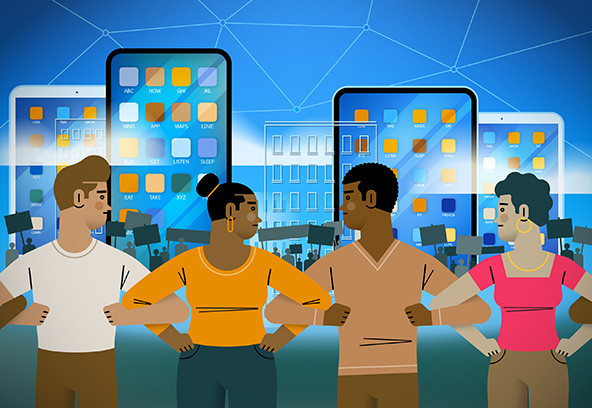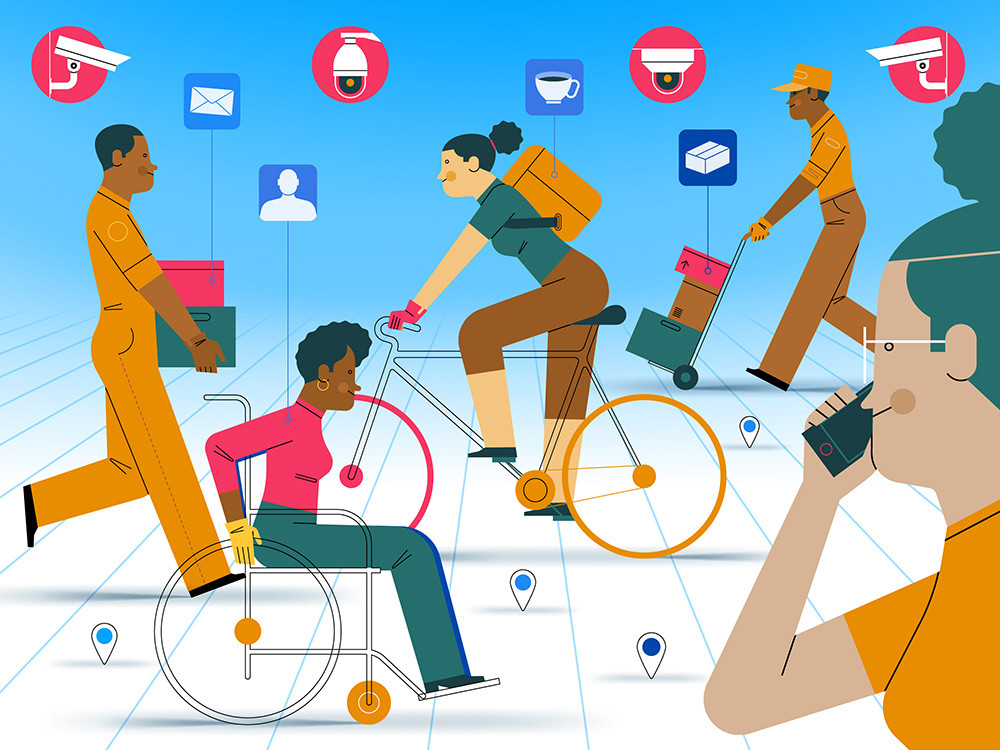 (Illustration by Hugo Herrera)
(Illustration by Hugo Herrera)
The economy doesn’t just happen. Neither do good jobs, or fair work. These are all the result of policy decisions we make as a society. That’s true of the past, but also today, as we face new technological advances that are transforming numerous industries, and the labor market with them.
As we settle uneasily into the age of platform gig work, algorithmic management, and artificial intelligence-driven automation, we tend to talk about technological innovation as though it’s a completely new challenge. It’s not. For centuries, the economy has gone through periods of rapid technological advancement that changes the nature of work—usually leading to increased productivity; sometimes displacing jobs, at least temporarily; but often ultimately replacing those lost jobs with something new. These changes tend not to happen all at once, but gradually over time.

That history demonstrates that today’s advances in automation and AI will not inevitably lead to mass unemployment, as some predict. But some industries, and some people, are always affected more than others. One thing that remains constant is the power dynamics involved in these transitions: Who is driving them? Who benefits? Who loses?
These questions are shaped by the underlying structures in our society and economy, which has historically meant that, in times of rapid technological change, the people with the most power control if and how the benefits are shared, while the people most vulnerable are those who are broadly marginalized already. The people making economic decisions today—in government, on Wall Street, in corporate boardrooms, and indeed in Silicon Valley—overwhelmingly look the same as they have since their creation, with virtually no racial, gender, or economic diversity. As in the past, that means the experiences and concerns they bring to the table rarely represent the people outside those rooms, or the issues most important to them, like safe, dignified, and stable work that provides a living wage, paid leave, health and retirement benefits.
As we grapple with new technological developments that would have been unimaginable 100 years ago, the most immediate, large-scale challenge to ensuring the tech revolution benefits everyone, and is a net positive for the future of work, is determining how those changes are implemented. And a large part of the solution is right in front of us: strengthening labor standards and enabling workers to have a voice through organizing and collective bargaining.
The benefits of a union are even more important amid our current tech transition, since nonunion workers have no right to be consulted over the ways technology changes their jobs, including through automation, workplace monitoring, surveillance, and more. But in the United States today, there is far greater demand for union representation than workers who have access to it; almost half of all US nonunion workers say they want to belong to a union, but only 12 percent do.
While the nature of the technology is different, if underlying social and economic structures remain the same as in previous eras, Big Tech will only perpetuate or amplify social and economic inequalities.
Currently, those inequalities are observed at the top and at the bottom of the tech industry. At the top, Silicon Valley tech firms have been repeatedly cited for their lack of diversity in leadership. At the bottom, the gig workers who make behemoth platform companies like Uber or DoorDash profitable are not classified as employees—with enforceable rights to a fair wage, decent working conditions and labor protections—but as independent contractors who are forced to take on all of the burdens and risks of business, often for subminimum wages and with little recourse when they’re mistreated or underpaid. A 2020 survey by the Shift Project found that 14 percent of gig workers said they’d earned less than the federal minimum wage, and more than a quarter had earned less than $10 per hour. More than 60 percent reported that they had not been paid for some of their working hours at least once, and 36 percent said they’d experienced such wage theft three times or more. Since people of color are disproportionately represented in gig work, and other positions in the tech industry where they’re misclassified as non-employees, the burden of these violations fall hardest on demographics that have historically faced job and wage discrimination.
This is where unions come in, not just as a force that gives workers a seat at the table, but as one that has historically helped level the playing field for historically marginalized workers.
Since the 1940s, Black workers—who have always faced unique disadvantages in the labor market—have had the highest rate of union membership of all racial demographics. And with good reason: Research has found that the racial wealth gap between Black and white families is nearly halved if those families belong to unions.
Union membership likewise brings significant benefits to women workers, raising their typical hourly wage by nearly 10 percent compared to non-unionized women. Workers in the service industries—where women are disproportionately represented—make almost 50 percent higher wages if they’re in a union.
Unions also have other, less tangible effects on equality, from unions’ historical support for Civil Rights and voting rights to the fact that today, as research by the Economic Policy Institute has found, states with higher union density are less likely to have voter suppression laws and more likely to have higher voter turnout.
But as political and corporate attacks on unions gained steam in the 1980s, damage was done not just to workers’ rights but to efforts to decrease racial wage disparities. In 2019, the median Black wage was nearly 25 percent less than that of the median white worker—a sharp increase from the racial wage gap in 1979.
Today, workers and unions face new threats from Big Tech companies, which are lobbying to enshrine new forms of inequality into law through aggressive anti-union campaigns. At state legislatures, in the courts and through ballot initiatives, platform companies have sought to weaken the legal tests used to determine whether workers must be classified as employees for the purpose of minimum wage, unemployment insurance, and labor and nondiscrimination protections; to pass preemptive state legislation that prevents local governments from setting their own, higher standards; and have disregarded labor laws under the assumption that they won’t be enforced or bring repercussions.
While these lobbying campaigns have tended to focus, on their face, on industries like ride hailing and delivery services, it’s clear that tech companies are hoping to expand their employment model more broadly, across all private businesses. One 2022 ballot initiative in California sought to redefine health-care workers as independent contractors if they use a digital platform to access work assignments. The same year, platform corporations partnered with other major employers in retail, media, transportation, logistics and construction to create the Coalition for Workforce Innovation, which seeks to designate more categories of workers as non-employees, and which backed a federal bill that would allow private employers to coerce workers into agreeing to exemptions from minimum wage or overtime protections.
Gig platform companies have also proposed and supported legal initiatives to create a “third category” of workers who are considered neither full employees nor independent contractors, with some success, including a 2021 law passed in Washington state. Under many of these bills, workers’ rights are severely limited, including their right to unionize. But even though busting unions harms workers of color, these companies have made the audacious claim that creating such a third category of workers is necessary in order to provide “economic opportunities to struggling immigrants and racial minorities.”
Attacks like these require a strong, organized, multi-layered response and there are policy solutions that could have cascading positive effects. A number of cities have already taken steps to establish minimum pay, as well as standards for safety and working conditions for app-based workers. States can combat misclassification by adopting or expanding ABC tests which require companies to prove a worker is an independent contractor instead of an employee. Nationally, the Protecting the Right to Organize (PRO) Act, which, if passed, would make it easier for people to join unions and get to a first union contract quicker, and establish harsher penalties for employers who union-bust or otherwise violate labor laws. The PRO Act would allow workers and the National Labor Relations Board (NLRB) to establish union election processes by themselves, removing the need for employers’ recognition or consent; prohibit employers from forcing workers to attend union-busting “captive audience” meetings; require the NLRB to take immediate action against employers who retaliate against workers for union activity; and, vitally, would make employee misclassification a violation of the National Labor Relations Act. The law would also help empower workers to challenge companies that use technology in abusive ways in the workplace.
The future is malleable, and it turns on the decisions we make. We can’t simply apply new waves of technology to our existing, flawed structures and expect anything different to happen than the repetition of our same old problems. As we transition to a digital economy, it’s imperative that we make choices that will ensure that its long-range outcomes are positive: increasing efficiency and productivity, yes, but also sharing those benefits more broadly across society. Strengthening labor standards and workers’ rights to join a union are two such choices.
Support SSIR’s coverage of cross-sector solutions to global challenges.
Help us further the reach of innovative ideas. Donate today.
Read more stories by Valerie Wilson.

